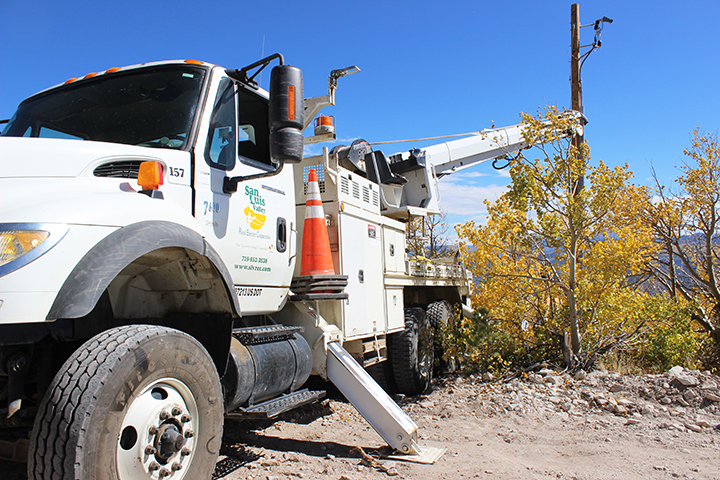About Us
Learn about our guiding principles, board of directors and more!
We are proud to be the second oldest electric cooperative in Colorado. We serve the counties of Rio Grande, Costilla, Saguache, Alamosa, Conejos, Mineral and Hinsdale. More than 8,200 member owners work with our team for power in their homes, schools, farms and other small businesses.
The San Luis Valley is original Colorado surrounded by majestic mountain ranges cradling the state’s most fertile valley at the headwaters of the historic Rio Grande — a spiritual center of indigenous American populations enhanced by a rich Hispano legacy that today embraces a natural diversity of the essence of Colorado. The uniqueness of this high altitude 8,000 square mile region is an expansive sense of place that has abundant sunshine, open blue skies and vivid starlit nights. With our distinctive communities and supportive business environment, the valley is a journey with a destination for everyone. This big city alternative promises to be a place that awakens your potential & sustains opportunity.
We are proud to be your cooperative!
Click here to view the 2022-2027 Strategic Plan

___________________________________________________________________________________________
New Electrify and Save Program expands access to beneficial electrification and energy efficiency to REC members

DENVER— Rural consumers can benefit from greater access to electrification and energy efficiency through a new program announced Friday from members of Tri-State Generation and Transmission Association, including San Luis Valley Rural Electric Cooperative (SLVREC). Administered by the Colorado Clean Energy Fund (CCEF), the Electrify and Save On-Bill Repayment Program will bring more affordable energy efficiency and electrification benefits to rural consumers. The effort also will be boosted by the announcement that Tri-State and its members have secured $75 million in loans for rural energy efficiency efforts, through the U.S. Department of Agriculture’s Rural Energy Savings Program (RESP).
In an event held Friday at the Colorado State Capitol, Gov. Jared Polis voiced support for the On-Bill Repayment Program, which will allow members and businesses in Colorado and across the West to install home improvement efficiency and beneficial electrification measures, at no up-front cost with the ability to repay over time through their monthly utility bill. Unlike traditional loan programs, unique underwriting criteria (rather than traditional loan underwriting criteria) assesses the member’s bill pay history, thereby qualifying a broader base of participants.
Eligible energy measures under the On-Bill Repayment Program include funding for new insulation, windows and doors, water heaters, heat pumps, HVAC systems, electric vehicle charging and other qualifying energy-efficient technology. The program also includes home energy assessments and vetting for authorized contractors. Because the financial obligation is tied to the service location, rather than the individual, this program also is unique from traditional consumer loan programs, in that it does not affect credit scores or create additional debt for the member consumer.
In many cases, the energy savings achieved through the newly installed measures are greater than the monthly repayment obligation, thereby saving consumer members and businesses money on their utility bill every month.
Tri-State Chief Executive Officer Duane Highley and CCEF Chief Executive Officer Paul Scharfenberger joined Gov. Polis today in announcing the program.
“With this opportunity, members of electrical co-ops that are Tri-state customers can easily update their heating and cooling to more energy efficient options without upfront costs, saving them money and supporting the state we love for generations to come,” Gov. Polis said.
Tri-State, its members and CCEF learned earlier last week that the U.S. Department of Agriculture had approved $75 million in loans to Tri-State through the RESP, to be used on energy efficiency efforts for its members; of that amount, $50 million in loans will be used to support the On-Bill Repayment Program. The RESP provides loans to rural utilities and other companies that, in turn, provide energy efficiency loans to qualified consumers who implement durable, cost-effective energy efficiency measures.
The first phase of the On-Bill Repayment Program, initially offered in March by SLVREC, is a standardized program developed by Tri-State, its distribution system members and CCEF. The Sangre de Cristo Electric Association (SDCEA) launched its on-bill repayment program last week, with other distribution cooperatives to initiate the program later this year. Eleven other members are planning to offer the program in the near future.
“Working together with Tri-State, our members are solving challenges and supporting the rural communities they serve” Highley said. “One of the historic roadblocks to helping consumers and businesses embrace energy efficiency and beneficial electrification has been securing access to the capital needed to make meaningful improvements that reduce their energy costs.”
With CCEF and our members, we have a solution that provides financing in a simple, transparent and cost-effective way,” Highley said.
Beneficial electrification refers to technology that takes advantage of a reliable, affordable and cleaner electric grid, thus reducing emissions and energy costs. For example, heat pumps can heat and cool homes using only electricity and their technology is highly efficient.
With energy expertise and significant assets under management, CCEF will act as the program administrator, directing activities of the program center; recruiting and enrolling authorized contractors; and managing financing disbursements and servicing.
“This program will help improve the lives of our members through energy savings and increased home values,” added Eric Eriksen, chief executive officer for SLVREC in Monte Vista, the first Tri-State member to offer the On-Bill Repayment Program. “I know this to be true because I’ve experienced the positive impacts of a similar program first-hand in Alaska.”
Find more information HERE.




